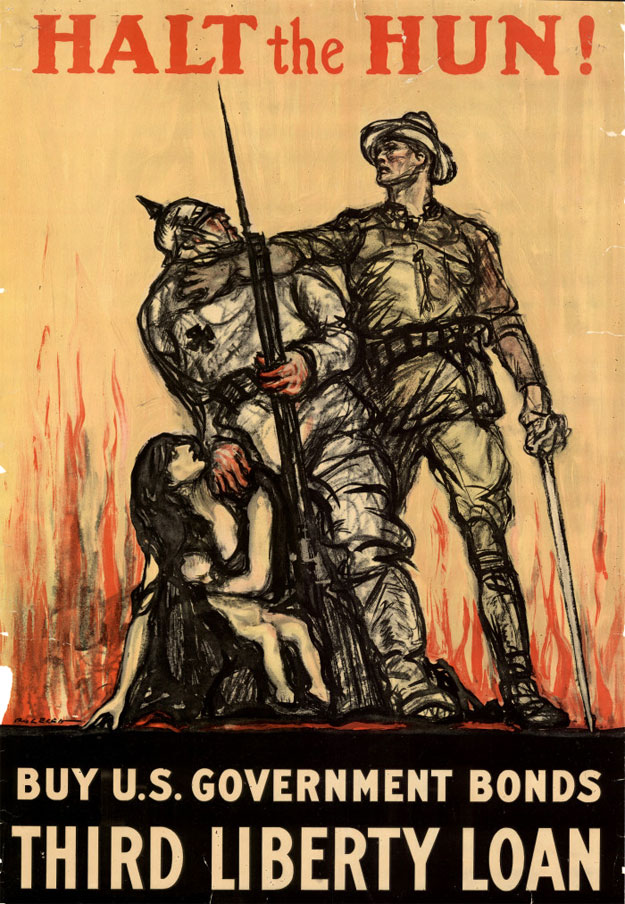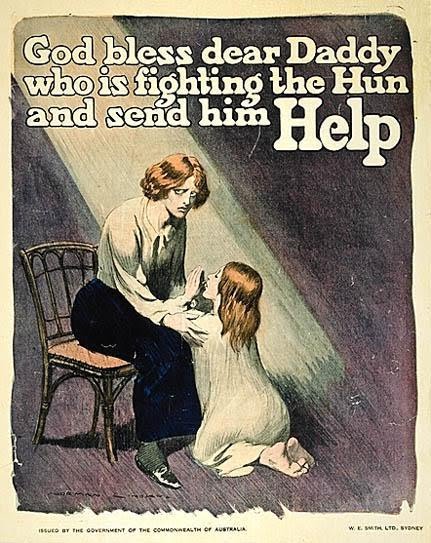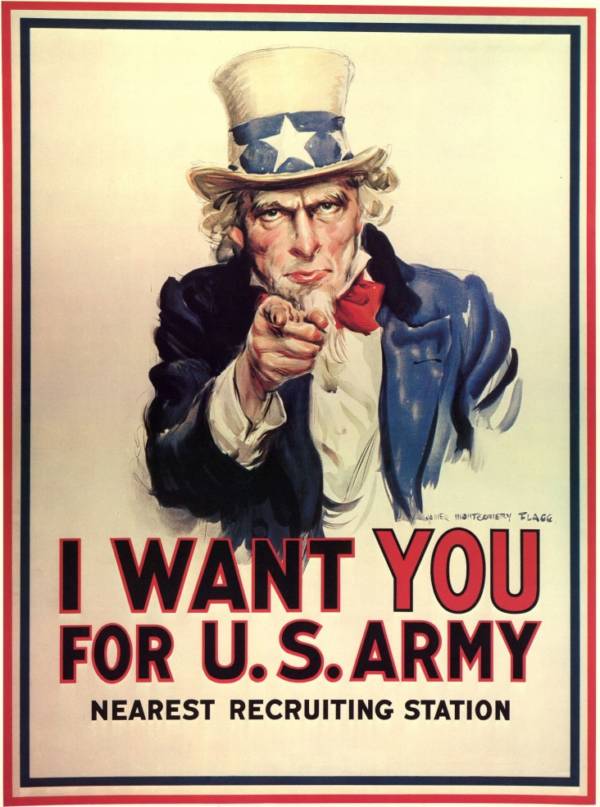World War I & The Birth of Mythic Nationalism
“When we look around at the rise of new forms of mythic nationalism in the hands of fascist and authoritarian groups, we’re seeing a continuation of the process that governments started during World War I.”
Today is Armistice Day (or Veterans Day, if you are in the United States), a day celebrating the end of the orgiastic slaughterhouse that was called “The Great War,” or “The War to End All Wars,” names abandoned quickly after an even “greater” war proved that it wasn’t actually a war to end any wars at all.
Now we call it World War I. In Anglo countries, it’s commemorated with fabric poppies and sober readings of poems; in Europe with speeches and sombre visits to graveyards. 11 million soldiers dead, another 8 million civilians killed by famine, disease, and bombings. Millions more (up to 20 million) maimed and wounded: 4% of the populations of Germany and France each killed by the end; much more in Serbia (up to 20%) and the Ottoman Empire (15%). The English-speaking world fared much better: 0.13% of the US, 0.81% of Canada, Australia 1.1%, the United Kingdom and its colonies around 2%.
Overall, the war is forgotten except on this day, overshadowed by its blockbusting follow-up, World War II. It’s understandable—the Great War 2.0 killed almost twice as many people and had a more compelling plot with more epic “heroes” (Churchill, De Gaul, Stalin, Roosevelt) and a much more charismatic and hateable villain (Hitler).
But it isn’t just the Second World War’s larger size that overshadows the first. Its lack of ambiguity makes it a more interesting, heroic story. World War II started with an obvious aggressor (who was also gassing Jews, Gays, and Romani); World War 1 started when a Serbian “anarchist” (in actuality, a Serbian nationalist) killed a totalitarian Archduke from the Austria-Hungary empire on his visit to Bosnia. That killing triggered a military response from Austria-Hungary, an attack on a sovereign nation. Russia was allied by treaty to Serbia and thus declared war on Austria-Hungary. France followed suit, triggering Germany (allied with Austria-Hungary) and the United Kingdom (allied with France and Russia) to declare war as well.
Confused? It’s even more complicated than that, and this is again one of the reasons why World War I doesn’t inspire the same sort of documentaries or historic films that World War II did. It wasn’t a war made for Hollywood: no side could claim moral high ground. All sides used chemical weapons (mustard gas being the favorite of the US military, having developed it in the first place); all sides engaged in torture, rape, indiscriminate killings of civilians, and other horrific “war crimes.” And unlike the Second World War, the First was more a war of attrition than of victory, a waiting game to see which side would internally collapse first. By the end, Russia became communist, the Ottoman and Austria-Hungary empires collapsed and were dismantled, and many new nations were carved from their carcasses.
National Identity and the “Great War”
That last point highlights perhaps one of the greatest reasons that World War I has become a faded memory, glossed-over in most histories and barely discussed in media or by political traditions on the left or the right. The “Great War” functions much like an event in pre-history, a “mythic event” like the biblical flood which, senseless and undirected, changed the very shape of the land across which it passed. None of the old maps made sense any longer: new empires arose from the ruins of old ones overnight, and what wasn’t claimed as imperial territory was re-designated along the lines of perhaps the most powerful new ideological framework birthed by the war: mythic nationalism.
As for many other aspects of modern society, nationalism and national-identity are both concepts which seem to stretch back in time. That is, much like capitalism or racial identity, it’s not only difficult for us to imagine a time before nationalism existed, but also to forget that there ever was a time in the first place. We have trouble conceiving of a Europe before Germany (1870) or Italy (1861) existed, just as we find it almost impossible to wrap our minds around the fact that white and black were not types of people in the 16th century.
Obviously, the people who we now think of as white, black, German, or Italian existed before the birth of racial identity or the founding of Germany and Italy—they just didn’t see themselves as such. Thus, it’s historically inaccurate to talk about 18th century Germans or white people in the Middle Ages of Europe, since those are new categories which we are attempting to superimpose upon the past. A similar problem would occur if we tried to make a statement about Christians in Ancient Greece—they didn’t exist yet, and only the birth of Christianity meant that it was then possible to talk about people being Christian.
As with Christianity, racial and national identities didn’t take hold instanteously after their creation. It takes decades and even centuries for people to adopt an identity after it exists on paper or in the ideological realm. However, there are certain interventions that can speed up that process, major events or movements by governments and other powerful entities which solidify the shift faster. For Christianity, it was the Roman persecution of Christians, and then later Christianized Rome’s slaughter of Pagan peoples, and even later the European Christian Crusades against Muslims. Racial identity was cemented through slavery, violence, and lynchings.
The absolute fastest way to solidify national identity is war, especially if that war is against other nations and not mere concepts like “Terrorism” or “Drugs.” This, more than anything, is why the “Great War” is particularly terrifying in its appearance of mythic history, because World War I was the first time that we have ever seen so many new national identities emerge simultaneously and so thoroughly.
This point is made particularly clear in Modris Eksteins’ profound historical study, The Rites of Spring. In that history of World War I, Eksteins focuses not on what the leaders of the war nations were doing, but rather on how common people saw themselves and what they understood themselves to be doing as they rushed to war.
It’s easy to forget, but there were plenty of people alive in Germany at the time who remembered a time before being “German” was a thing at all, whilst those under 40 never knew a time when there was no Germany. The German government had to mobilize the German population to go to war with France and Russia on behalf of Austria-Hungary’s spat with Serbia, and the only way they were able to do this was to appeal to this new German identity. That identity was still weak, however, so they had to appeal not just to national identity as a thing-in-itself, but also national identity as a thing-in-opposition. Thus, it wasn’t just the German people at war against France, but the German people at war against the French people.
We can’t limit this to only Germany, however. France (which had existed longer, but was even still in the process of solidifying French identity) did the same, as did the United Kingdom, Russia, and later the United States and Canada. Each created and heavily relied-upon a sense of unified national identity to gain support for the “war effort” from common people who had no personal interest in Archduke Ferdinand’s assassination by a Serbian.
The Creation of Mythic Nationalism
The national identities and nationalisms which arose from the propaganda machines of each war power relied heavily on the mythic. They evoked (non-existent) ancient histories of the “people,” created posters depicting idealized and caricatured forms of what a real German or French person looked like, while musicians, dramatists, film-makers, novelists, and other artists in the employ of capitalists supplemented the new nationalist myths with their own contributions.
Most of us are accustomed to thinking about the creation of mythic nationalism in terms of Nazi Germany, and thus perhaps it seems a bit odd to think of all these things happening in World War I. The truth is that all these things began before Hitler (who was, incidentally, gassed by British forces in a trench during the “Great War”), and the governments involved in World War II had only gotten better at the work they started in that earlier war.
To understand this point a little better, it’s useful to look at many of the buried aspects of United States involvement in World War I. As with most other participants, the United States had no clearly defensible stake in going to war with the Central Powers, nor did the war in Europe directly affect the lives of most common Americans. More so, conscription (“the draft”) didn’t exist in the US until the war, and only five years before the founding of Germany in Europe, the United States had just finished a bloody civil war.
American identity was hardly solid, and thus the government of Woodrow Wilson had quite a lot of work to do to convince Americans to go fight elsewhere. Besides the often forgotten imprisonment of anarchists, communists, and war dissenters under the Espionage and Sedition acts, the US government relied heavily upon the same sort of nationalist propaganda every European power did, with mythic representations of Americans, the “goddess” Columbia, Uncle Sam, and other civil-religious iconography, while also caricaturing the German people as “Huns” and gorillas.
The result of all this was that, by the end of the “War to End All Wars,” the people of each nation involved in that war had been so thoroughly propagandized into new national identities that there was no longer need to convince people they were “French” or “British” or “German.” This fact (as Eksteins makes clearly in The Rites of Spring) is what enabled Hitler and his Nazi party to evoke German identity in their seizure of power, and expand it to even greater mythic proportions through the concept of the Aryan race. This is also what enabled all the leaders of other powers to do similar (though without the concentration camps) in the second World War, and why we now find ourselves in a modern age where national identity seems to have always existed and to be an integral part of ourselves, rather than being a constructed identity disciplined into our great grandparents.
Fascism: Mythic Nationalism’s Fulfillment
Thus, when we look around at the rise of new forms of mythic nationalism in the hands of fascist and authoritarian groups, we’re seeing a continuation of the same process that governments started during World War I. That rise is also not what many suggest: it is not a “reactionary” or “backward” tendency. Eksteins controversially points out in The Rites of Spring that mythic nationalism is a uniquely modern phenomenon and is a product of Modernism itself.
To understand this, we need to look at the order that proceeded the modern period and the first world war. Before the modern was the Enlightenment, the period of secular humanism governed by Protestant morals and a “scientific” view that humanity could be perfected through proper government, education, and well-administered institutions like schools and prisons. The Modern was a continuation of this, but with the re-addition of a crucial quality that the Enlightenment tried to destroy: public belief in the mythic.
In the Middle Ages, people believed in Gods and saints. They believed the Devil existed, believed there were witches, believed that magic and the stars and certain places could influence events and the course of one’s life. The Enlightenment sought to eradicate all such belief and replace it with Reason and Science, but merely succeeded in alienating people from each other and creating governments that could only repress or oppress heretical ideas. The Modern era, born most fully during the First World War, kept the institutions of the Enlightenment but re-introduced the suppressed mythic. But instead of belief in God and Magic, the Modern introduced belief in the Nation and its mythic destiny.
This belief persists each time we hear a person speak of America as “a land of opportunity” or a defender of “freedom,” or when we speak of people from a country in nationalist terms (the British, the French, etc.). We have come to believe that we are part of something bigger, that we share fate and destiny with other people in “our nation,” and most of all we have come to believe that nations are indestructible things, living gods imbued with eternal characteristics. In the hands of fascists and other authoritarian groups, these Modern beliefs only intensify. “Make America Great Again” is not an aberration of nationalism, it’s the logical conclusion of nationalism. The same applies to the various nationalist identity groups in Europe and the rise of fascist groups in the Global South as well.
We have World War I to thank for this, and it’s not clear what new intervention the governments of the world plan next to solidify their hold over our mythic imagination. The Fascists offer a re-invigoration of the dying national myths upon which all the modern nations of the world are sustained. Neo-liberal re-imaginings of the world into mythic “global connection” through internet technology and authoritarian institutions such at the European Union are collapsing as well.
Neither of these options are good. Perhaps into this space a new mythic imaging might erupt, one which cannot be wielded by governments, capitalists, or authoritarian forces. The secularist Enlightenment failed and brought only destruction; the Modern is crumbling around us. May that something be born, and soon.
Rhyd Wildermuth
Rhyd is one of the co-founders and co-editors of Gods&Radicals. His recently released collection, Witches In a Crumbling Empire, is available now. You can support him on Patreon, and listen to his podcasts with Alley Valkyrie, Empires Crumble.








